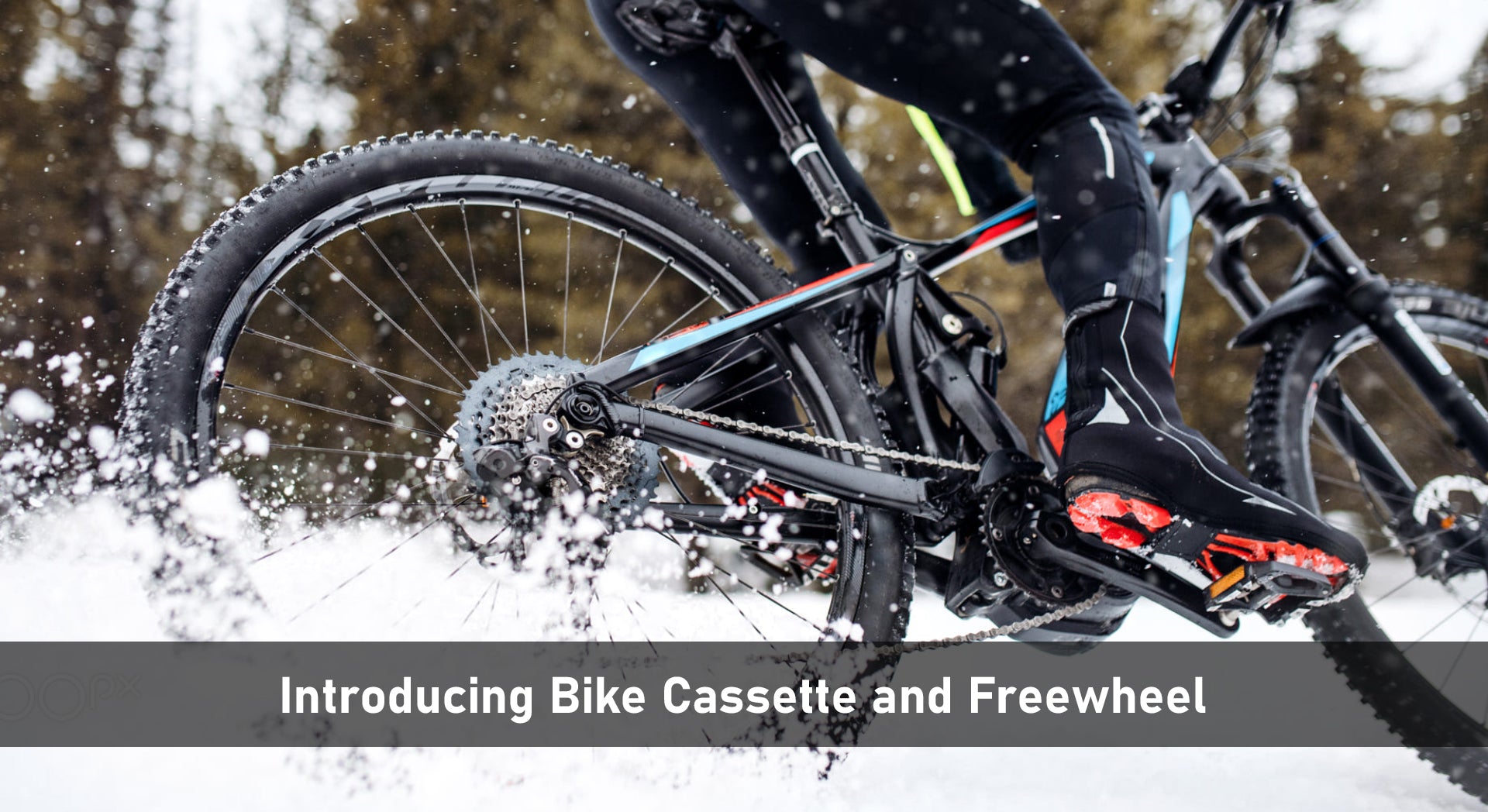What is a Cassette?
In the realm of bicycles, a cassette refers to a set of gears connected to the freehub body of the rear wheel. It is an integral part of multi-speed bicycles, containing multiple gears of different sizes that riders can select using the derailleur to adapt to various riding conditions and terrains.
A typical cassette usually consists of several sprockets fixed onto a common carrier. Each sprocket varies in size, with smaller ones providing higher gears (speeds) and larger ones offering lower gears (speeds). By adjusting the position of the rear derailleur, riders can move the chain from one sprocket to another, achieving gear changes.
The choice of a bicycle cassette can be customized based on a rider's personal preferences and riding requirements. For example, a larger sprocket may provide more climbing power on hills, while a smaller one may offer higher speeds on flat terrain.
How Does a Cassette Work?
The operation of a bicycle cassette involves the freehub body on the rear wheel, the rear derailleur, and the chain connected to them. Here is a basic overview of how a cassette functions:
- Freehub: The rear wheel of a bicycle features a freehub, a device mounted on the hub allowing the tire to roll freely when the pedals are not in motion. A special nut on the freehub connects it to the cassette.
- Sprocket Set (Cassette): The sprocket set consists of multiple gears of varying sizes, attached to the "nut" on the freehub, forming a unified assembly.
- Chain: The bicycle chain connects the front crankset and the rear sprocket set (cassette). The length and tension of the chain are regulated by the front and rear derailleurs.
- Derailleurs: The front and rear derailleurs are responsible for shifting between the front crankset and the rear sprocket set. When a rider operates the gear shifter, the derailleurs guide the chain from one sprocket to another.
Shifting Process: As the rider pedals, the chain drives the rotation of the sprocket set. Through adjustments by the derailleurs, riders can select different gears, providing higher speeds or greater climbing power to adapt to varying terrains and riding situations.
What is a Freewheel?
A freewheel is a device on the rear wheel of a bicycle that allows the tire to roll freely when not pedaling, without affecting the rotation of the pedals and gears. It enables riders to coast effortlessly when the pedals are stationary.
The primary components of a freewheel include:
- Sprockets: These are a set of gears connected to the freewheel, usually comprising multiple differently-sized sprockets, forming a removable unit. These sprockets are often designed as a single unit and installed on the freewheel.
- Freewheel Body: The freewheel body is a device that permits the gears to rotate freely when the rider stops pedaling, without impeding the rolling of the tire. The freewheel body contains an internal mechanism with bearings and springs that allow the gears to rotate freely in one direction while remaining connected to the freewheel in the other.
The freewheel is typically integrated with the hub, mounted on the rear wheel of the bicycle. While freewheel systems were common in the past, modern bicycles more frequently utilize the freehub system, which shares fundamental principles with the freewheel but boasts a more modern design and certain advantages. In the freehub system, the freehub and bearings are mounted on an independent component called the freehub body, making it easier to replace the sprocket set without replacing the entire freewheel.
Distinguishing Between the Two


Freewheel and cassette are both components on the rear wheel of a bicycle related to the gearing system, and they exhibit significant differences in structure and operation.
- Structural Position:
Freewheel: The freewheel typically includes a sprocket set directly threaded onto the hub.
Cassette: The sprocket set of the cassette is separate and usually mounts directly on the freehub body, a component that can freely rotate while the sprocket set can be detached and replaced.
- Replacement and Maintenance:
Freewheel: In the freewheel system, replacing the sprocket set often requires changing the entire freewheel unit.
Cassette: In the cassette system, individual sprockets can be replaced without changing the entire freehub body, offering greater flexibility and cost-effectiveness in maintenance.
- Standardization and Compatibility:
Freewheel: Freewheel lacks robust standardization in design, leading to potential compatibility issues between different brands and models.
Cassette: The cassette system is more easily standardized, often adopting industry standards, facilitating the use of cassettes from different manufacturers on the same freehub body.
- Era and Popularity:
Freewheel: Freewheel systems were more common in the past but are relatively less prevalent in modern bicycles.
Cassette: Cassette systems are the mainstream in modern bicycles, especially in high-performance and multi-speed gear systems.
In summary, the cassette system is more flexible, easy to maintain, and offers better compatibility compared to the freewheel system. The use of freewheel systems in the bicycle industry has become relatively uncommon, while the cassette system aligns better with modern bicycle design and riding needs.
Understanding the Importance of Identifying Your Bike's Cassette or Freewheel System
Knowing whether your bike uses a cassette or freewheel system is crucial for riders. This understanding involves the design of the rear wheel and the transmission system, directly influencing subsequent maintenance, upgrades, and the selection of appropriate accessories.
- Maintenance and Replacement:
Cassette: If your bike uses a cassette system, the separation of the sprocket set and freehub body allows for more flexible maintenance. You can replace individual sprockets without changing the entire freehub body, reducing maintenance costs and providing more options.
Freewheel: In a freewheel system, the sprockets and freewheel body are a single unit, potentially requiring the replacement of the entire freewheel. This may increase the difficulty and cost of maintenance.
- Upgrades and Flexibility:
Cassette: Due to the design of the cassette system, upgrading the sprocket set or adjusting the gearing system becomes more straightforward. You can choose sprocket sets with different tooth counts and speeds to meet various riding needs.
Freewheel: In a freewheel system, the options for upgrades and adjustments are relatively limited, as replacing the entire freewheel may involve more work and cost.
- Accessory Selection:
Cassette: Understanding that your bike uses a cassette system makes it easier to choose compatible accessories such as rear derailleur kits, wheelsets, etc. There is a broader market for accessories compatible with cassette systems.
Freewheel: If your bike uses a freewheel system, ensure that the chosen accessories are compatible with this rear wheel system to avoid mismatches and future complications.
- Repairs and Consultations:
Cassette: When undertaking repairs or seeking advice from professional technicians, knowing that your bike uses a cassette system allows for more accurate recommendations and support.
Freewheel: If issues arise, informing technicians that your bike uses a freewheel system is crucial information, as they may need to understand the specific design of your bike.
In conclusion, understanding whether your bike uses a cassette or freewheel system is highly important for riders. This knowledge facilitates better management and maintenance of the bike, the selection of suitable accessories, and enhances flexibility and comfort during rides.
Purchase products through https://yosepower.com/?ref=FROMLILY and get €10 off with this “YOSELILY” discount code!


Share:
Sharing Happy Time with Friends: E-Bikes Become a New Social Favorite
Exploring the Versatility of E-Bikes